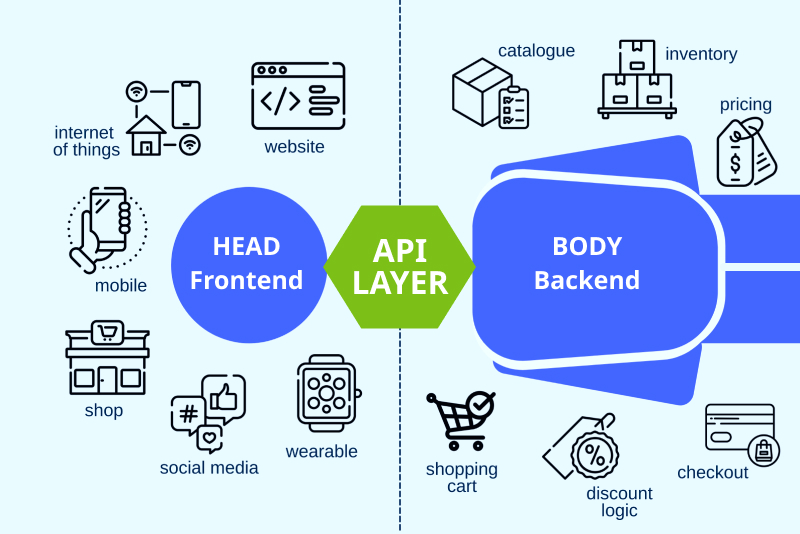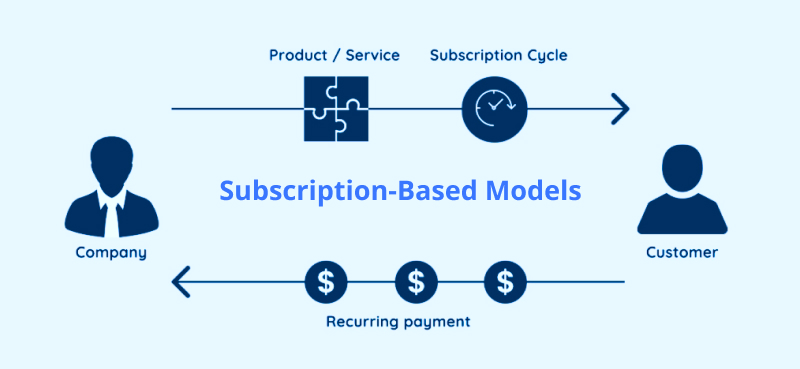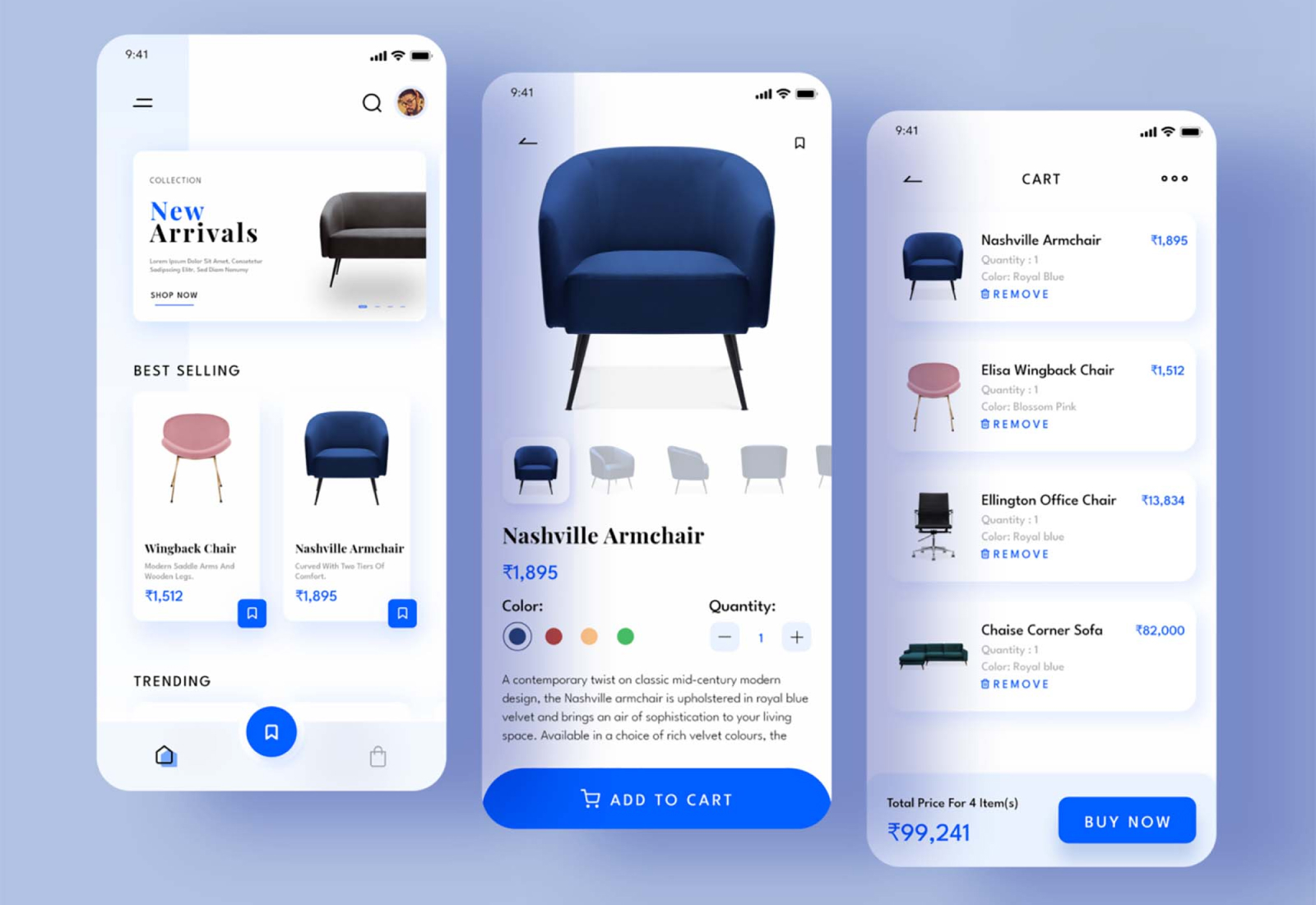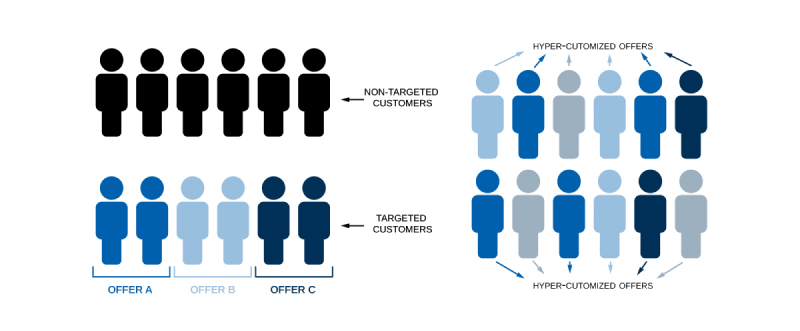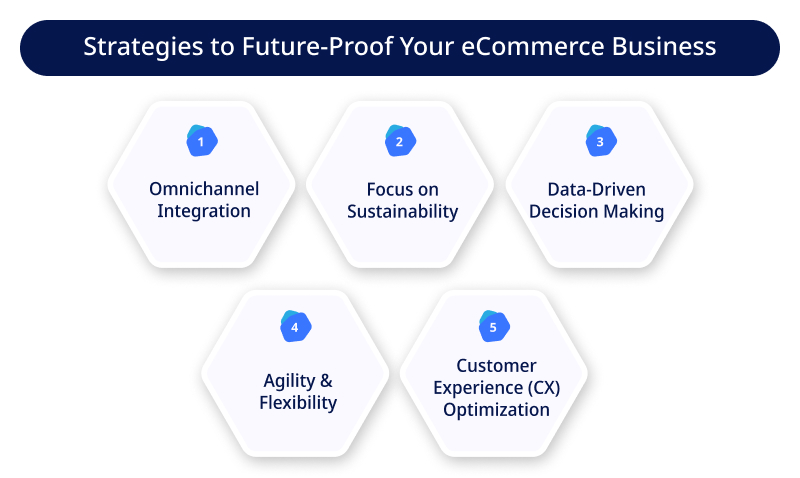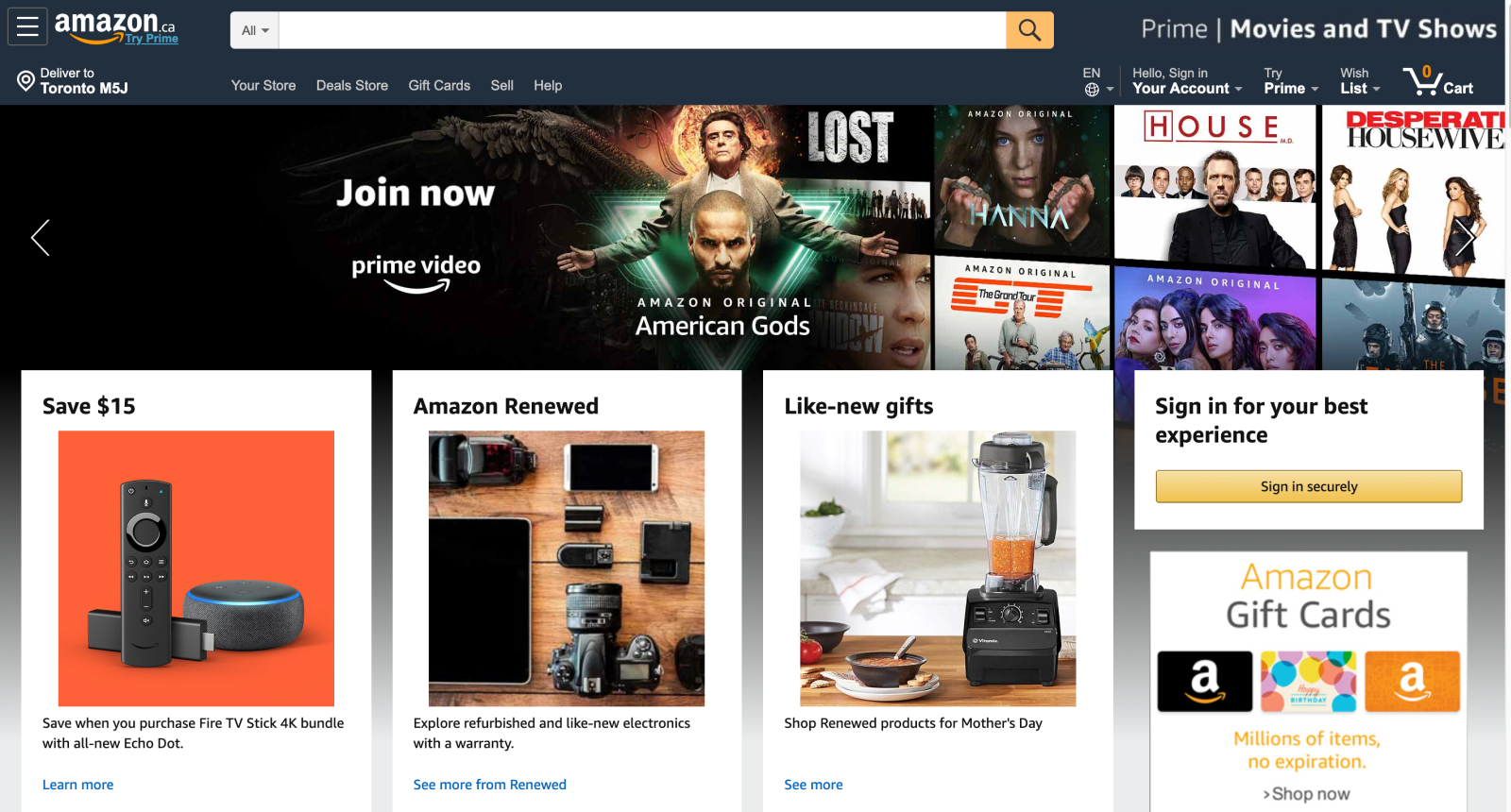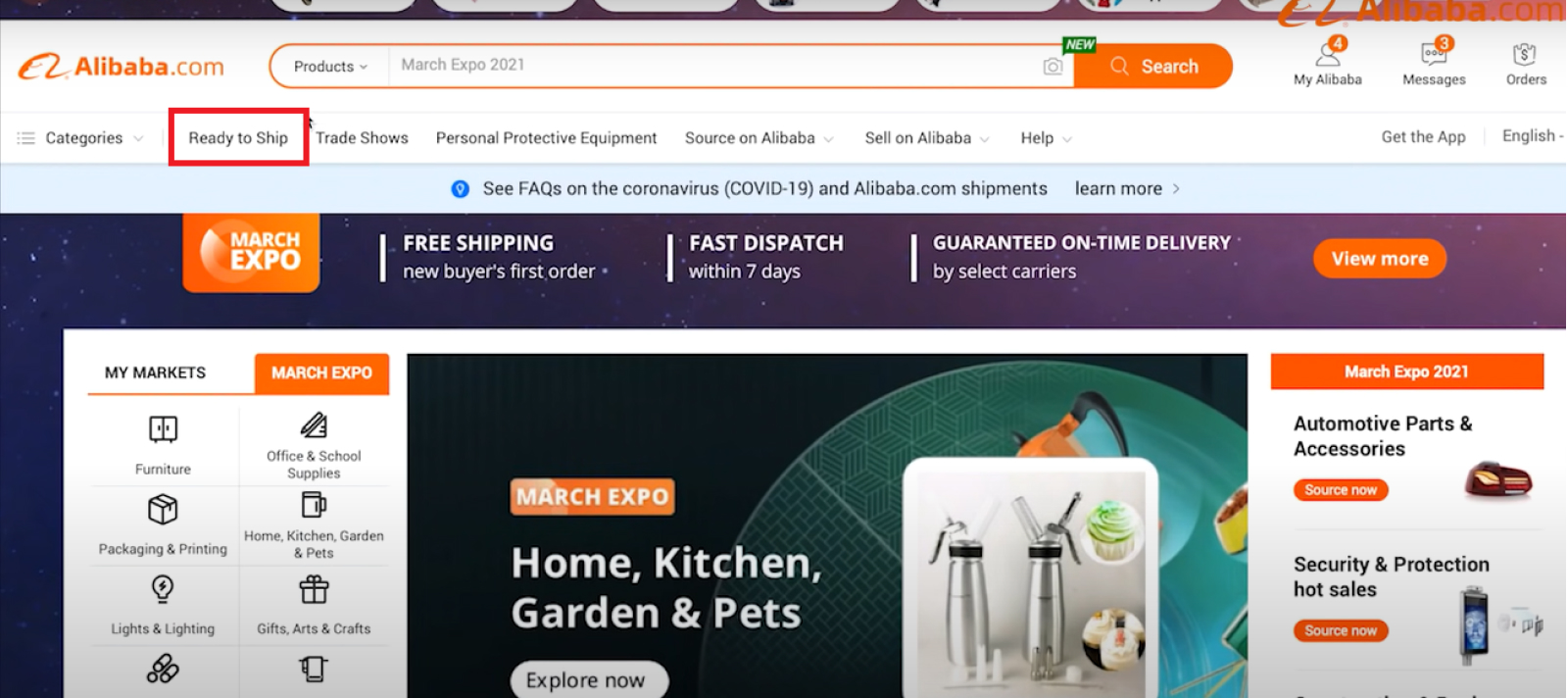As businesses navigate the ever-evolving digital landscape, eCommerce development emerges as a crucial frontier.
From traditional brick-and-mortar stores to online marketplaces, the shift towards eCommerce is undeniable.
Are you facing challenges in reaching customers or streamlining operations? Wondering what lies ahead in the world of online retail?
Explore how eCommerce development can address these pain points and propel your business forward.
This whitepaper is your roadmap to understanding emerging trends, innovative technologies, and strategic insights shaping the future of eCommerce development.
Table of Contents
The Impact of COVID-19 on eCommerce
In the wake of the COVID-19 pandemic, the landscape of eCommerce has undergone a seismic shift, reshaping consumer behavior and industry dynamics.
Let’s explore the critical impacts of this global crisis:
A. Accelerated Digital Transformation: Adapting to the New Normal
The COVID-19 pandemic sped up the move to digital platforms, pushing businesses to rely more on eCommerce for sales, aligning with eCommerce predictions for increased online activity.
This global crisis has affected vital economies such as the United States, China, India, and Italy, Mordor Intelligence said.
Consequently, European and North American markets are anticipated to bear significant impacts.
Companies swiftly pivoted their strategies to accommodate online shopping trends, focusing on enhancing their digital presence and optimizing user experience.
- Online retail sales surged by 27.6% in 2020, reaching $4.28 trillion globally.
- Businesses across industries rapidly adopted eCommerce solutions to stay afloat amidst lockdowns and restrictions.
B. Shifting Consumer Behavior: From Offline to Online Shopping
With lockdowns and social distancing measures, consumers turned to online channels for their shopping needs, marking a significant shift in purchasing behavior.
The convenience and safety of eCommerce platforms have become paramount for shoppers worldwide.
- Online grocery sales surged by 54% in 2020, with consumers prioritizing contactless delivery options.
- Traditional brick-and-mortar retailers embraced eCommerce to stay connected with customers and drive sales.
You can contact eCommerce service providers to explore innovative eCommerce business ideas to kickstart your online venture and thrive in the digital marketplace.
C. Supply Chain Disruptions & Logistics Challenges
The pandemic exposed vulnerabilities in global supply chains, leading to disruptions and delays in product delivery.
Logistics challenges, including transportation bottlenecks and labor shortages, strained eCommerce operations, prompting businesses to reevaluate their sourcing and distribution strategies.
- Nearly 94% of Fortune 1000 companies experienced supply chain disruptions due to COVID-19.
- Businesses sought to mitigate risks by diversifying suppliers and investing in robust logistics networks.
Discover how top eCommerce development companies are revolutionizing online businesses with innovative solutions and cutting-edge technology.
Market Analysis – The Global eCommerce Landscape
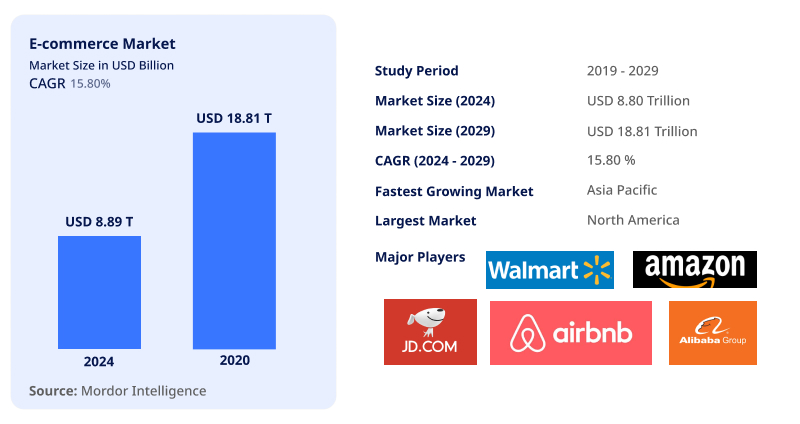
Let’s talk numbers…
According to Mordor Intelligence, the eCommerce market is witnessing exponential growth, projected to reach USD 8.80 trillion in 2024.
It is expected to reach USD 18.81 trillion by 2029, boasting a CAGR of 15.80% during the forecast period.
The proliferation of smartphones and increased internet penetration fuels this expansion, offering various online opportunities across multiple sectors like digital content, financial services, and e-tailing.
- As consumers become more tech-savvy, the market experiences a positive impact on the growth of eCommerce.
- Established businesses and corporations are increasingly transitioning to online platforms due to cost-effectiveness and wider reach.
- Online marketing tools such as Google and Facebook ads drive eCommerce growth.
- Small and medium-sized businesses are rapidly expanding, particularly in emerging markets like India, China, South Africa, and Russia.
Government initiatives like Make in India and Start-up India stimulate market growth by fostering a conducive environment for internet-based businesses.
However, challenges persist, such as the lack of technical infrastructure deployment in rural areas of countries like India, China, and Brazil, which may hinder market expansion.
Enhance user satisfaction and streamline navigation with optimized eCommerce solutions prioritizing ease of use and functionality.
Trends in eCommerce Development
The landscape of eCommerce development is constantly evolving, driven by changing consumer preferences and technological advancements.
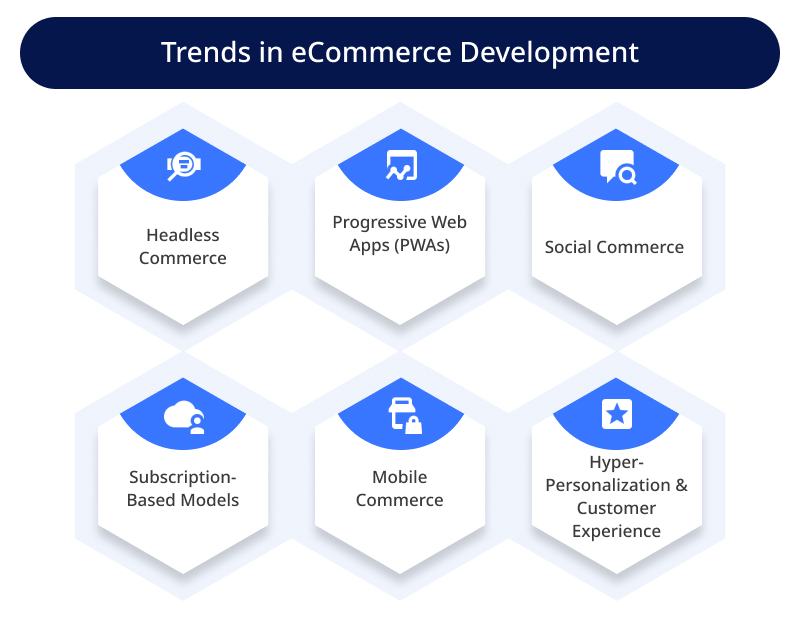
1. Headless Commerce: Decoupling Frontend & Backend for Flexibility & Speed
Headless commerce has emerged as a game-changer in today’s fast-paced digital landscape, offering unparalleled flexibility and agility in eCommerce development.
By separating the frontend presentation layer from the backend logic, businesses can adapt quickly to changing market demands and deliver seamless omnichannel experiences.
Key Considerations –
a. Enhanced Flexibility
With headless architecture, companies can experiment with new frontend technologies without disrupting backend functionalities.
b. Faster Time to Market
Decoupling frontend and backend allows for parallel development, reducing time-to-market for new features and updates.
c. Omnichannel Optimization
Headless commerce enables consistent brand experiences across various touchpoints, including websites, mobile apps, and IoT devices.
d. Scalability & Customization
Businesses can scale their eCommerce platforms effortlessly and tailor customer experiences to meet specific needs and preferences.
Explore our comprehensive guide to find the best eCommerce platforms for your business needs, ensuring seamless online operations and maximum growth potential.
2. Progressive Web Apps (PWAs): Blurring the Line Between Websites & Native Apps
Progressive Web Apps (PWAs) represent the convergence of web and mobile technologies, offering users the best of both worlds.
These lightweight, fast-loading applications provide an app-like experience directly through the browser without the need for installation.
Key Considerations –
a. Enhanced User Experience
PWAs offer native app-like experiences, including offline functionality, push notifications, and smooth navigation.
b. Improved Performance
With faster load times and reduced data consumption, PWAs ensure a seamless user experience across devices and network conditions.
c. Increased Engagement
Push notifications and home screen shortcuts keep users engaged and encourage repeat visits, leading to higher conversion rates.
d. Cost-Effectiveness
Developing a single PWA that works across platforms eliminates the need for separate iOS and Android apps, saving time and resources.
The best online ecommerce platforms offer a range of features and tools to help businesses succeed in the digital marketplace.
3. Social Commerce: Leveraging Social Media Platforms for Direct Sales
In today’s interconnected world, social media platforms have evolved beyond mere communication tools to become powerful channels for eCommerce.
Social commerce leverages the massive user bases of platforms like Facebook, Instagram, and Pinterest to drive direct sales and engage with customers.
Key Considerations –
a. Seamless Shopping Experience
Social commerce directly integrates product discovery and purchase processes within social media platforms, streamlining the customer journey.
b. Enhanced Targeting & Personalization
Social media platforms provide valuable data insights that enable businesses to target specific audience segments with personalized offers and recommendations.
c. Influencer Marketing Opportunities
Collaborating with influencers and brand ambassadors on social media can amplify brand visibility and credibility, driving sales and brand loyalty.
d. Social Proof & User-generated Content
User reviews, ratings, and social shares contribute to social proof, influencing purchasing decisions and fostering trust among potential customers.
Looking to streamline your eCommerce project? Consider the benefits of outsourcing eCommerce development to expert teams for efficient and cost-effective solutions.
4. Subscription-Based Models: Enhancing Customer Loyalty & Lifetime Value
Subscription-based eCommerce models have gained popularity recently, offering businesses a predictable revenue stream and customers a convenient and personalized shopping experience.
By providing subscription options for products or services, businesses can foster long-term customer relationships and maximize lifetime value.
Key Considerations –
a. Predictable Revenue Streams
Subscription-based models offer recurring revenue, providing businesses with financial stability and predictability.
b. Enhanced Customer Loyalty
Subscribers feel a sense of commitment to the brand, leading to higher retention rates and increased customer lifetime value.
c. Personalization & Customization
Subscription services allow businesses to tailor offerings to individual preferences, delivering curated experiences that resonate with customers.
d. Upselling & Cross-selling Opportunities
By analyzing subscriber data and behavior, businesses can identify opportunities to upsell additional products or cross-sell complementary eCommerce implementation services, increasing revenue.
5. Mobile Commerce (M-Commerce) Dominance
With the widespread adoption of mobile devices and smartphones, mobile commerce (m-commerce) has become dominant in eCommerce.
As customers increasingly rely on mobile devices for shopping, businesses must prioritize mobile optimization to remain competitive.
Key Considerations –
a. Mobile-First Design
Designing eCommerce experiences with mobile users in mind ensures seamless navigation, fast load times, and intuitive user interfaces.
b. Mobile Payment Solutions
Offering secure and convenient mobile payment options, such as one-click checkout and digital wallets, streamlines the purchasing process and reduces friction.
c. Responsive Design & Cross-Device Compatibility
Responsive web design ensures that eCommerce websites adapt to various screen sizes and devices, providing consistent experiences across desktops, tablets, and smartphones.
d. Mobile Marketing Strategies
Leveraging mobile-specific marketing channels, such as SMS, push notifications, and mobile apps, helps businesses reach and engage with mobile users effectively.
Transform your online storefront with expert eCommerce web design services, tailored to enhance user experience and drive conversions.
6. Hyper-Personalization & Customer Experience
Hyper-personalization in eCommerce involves leveraging data and advanced analytics to deliver highly tailored experiences to individual customers.
By understanding each customer’s preferences, behavior, and context, businesses can create personalized recommendations, promotions, and content that resonate with customers on a deeper level.
Key Considerations –
a. Data-driven Insights
Collecting and analyzing customer data from various touchpoints enables businesses to gain actionable insights into customer behavior, preferences, and purchase history.
b. AI & Machine Learning
Artificial intelligence (AI) and machine learning algorithms can process vast amounts of data to predict customer preferences and deliver personalized recommendations in real time.
c. Dynamic Content & Product Recommendations
Dynamically generated content and product recommendations ensure that each customer receives relevant and timely offers, increasing the likelihood of conversion.
d. Personalized Customer Support
Providing personalized customer support through chatbots, virtual assistants, or dedicated account managers enhances the shopping experience and fosters customer loyalty.
Position your brand as a leader in your industry by optimizing your eCommerce platform for success with our professional services.
Strategies for Future-Proofing Your eCommerce Business
As the eCommerce landscape evolves, businesses must adapt to stay ahead.
Let’s explore strategies for future-proofing your eCommerce business.
A. Omnichannel Integration: Seamlessly Connecting Online & Offline Experiences
Are you maximizing the potential of omnichannel retailing?
Integrate your online and offline channels to deliver a seamless shopping experience for customers.
Here’s how:
- Unified inventory management across all channels ensures product availability and reduces stockouts.
- Implement click-and-collect options to bridge the gap between online browsing and in-store purchasing.
- Utilize customer data to personalize interactions and promotions across all touchpoints.
For Example –
Starbucks’ mobile app allows customers to order ahead and pick up in-store, enhancing convenience and loyalty.
B. Focus on Sustainability: Meeting Consumer Demand for Eco-Friendly Practices
Are sustainability initiatives part of your eCommerce strategy?
Cater to environmentally conscious consumers by prioritizing eco-friendly practices:
- Source sustainable materials and packaging to reduce your carbon footprint.
- Highlight your commitment to sustainability in marketing campaigns to resonate with eco-conscious shoppers.
- Offer incentives for eco-friendly behaviors, such as recycling programs or carbon offset options.
For Example –
Patagonia’s commitment to sustainability and environmental activism resonates with consumers who prioritize ethical shopping.
C. Data-Driven Decision Making: Leveraging Analytics for Insights & Optimization
Data is invaluable for understanding customer behavior and optimizing business strategies.
Here’s how to leverage analytics effectively:
- Track key performance indicators (KPIs) like conversion rates, customer lifetime value, and average order value to identify areas for improvement.
- Utilize predictive analytics to anticipate customer behaviors and preferences, allowing targeted marketing campaigns.
- Implement A/B testing to optimize website elements and enhance user experience based on data-driven insights.
For Example –
Amazon uses sophisticated algorithms to analyze customer data and personalize product recommendations, driving sales and customer satisfaction.
D. Agility & Flexibility: Adapting to Rapid Changes in the Market
How agile is your eCommerce business?
Stay ahead of eCommerce industry trends and disruptions by embracing flexibility:
- Adopt agile methodologies to streamline development processes and quickly respond to changing customer needs.
- Cultivate a culture of innovation and experimentation to foster adaptability within your organization.
- Forge strategic partnerships and collaborations to tap into emerging opportunities and stay competitive.
For Example –
Zara’s fast-fashion model allows them to quickly adapt to changing fashion trends and consumer demands, maintaining relevance in the competitive retail market.
E. Customer Experience (CX) Optimization: Enhancing Engagement & Loyalty
A positive customer experience is crucial for driving engagement and fostering loyalty.
Here’s how to optimize CX:
- Personalize the shopping journey with tailored product recommendations and targeted messaging.
- Provide seamless and intuitive navigation to enhance user experience and minimize friction points.
- Implement proactive customer support initiatives to address queries and concerns in real time, fostering trust and loyalty.
For Example –
Sephora’s Beauty Insider program offers personalized recommendations, exclusive perks, and rewards, fostering customer loyalty and repeat purchases.
Innovative eCommerce Brands Leading the Way
Are you curious about the pioneering eCommerce brands shaping the future landscape of online retail?
Let’s explore some innovative leaders who are setting new standards and pushing boundaries:
1. Amazon: Redefining Convenience & Customer Experience
- Prime Membership: Offering exclusive perks like fast shipping, streaming services, and discounts.
- Personalization: Utilizing advanced algorithms to recommend products tailored to individual preferences.
- Voice Commerce: Pioneering voice-assisted shopping through devices like Amazon Echo.
2. Shopify: Empowering Entrepreneurship with Seamless Solutions
- Easy Setup: Allowing businesses to create online stores quickly with customizable templates.
- Multi-Channel Selling: Enabling merchants to sell across various platforms, including social media and marketplaces.
- App Ecosystem: Providing a wide range of apps and integrations to enhance store functionality.
3. Alibaba: Connecting Global Markets & Sellers
- Cross-Border Trade: Facilitating transactions between international buyers and sellers.
- Data-Driven Insights: Leveraging big data to identify market trends and consumer behavior.
- Innovative Payment Solutions: Introducing platforms like Alipay for secure and convenient transactions.
4. Warby Parker: Disrupting the Eyewear Industry with Direct-to-Consumer Model
- Virtual Try-On: Offering a virtual try-on feature for selecting glasses online.
- Home Try-On Program: Customers can try multiple frames at home before purchasing.
- Social Impact: Integrating social responsibility into their business model with initiatives like “Buy a Pair, Give a Pair.”
Stay ahead of the competition with our innovative eCommerce solutions designed to fuel success.
Key Takeaways
The future of eCommerce development is ripe with exciting possibilities and opportunities for growth. As technology evolves, businesses must stay ahead of the curve to remain competitive in the dynamic eCommerce landscape.
Companies can redefine how consumers interact with their brands online by embracing emerging future trends in eCommerce development such as AI, omnichannel, and so on experiences.
As you navigate the ever-changing eCommerce landscape, remember the importance of staying informed and adaptable.
Consider partnering with a trusted eCommerce development partner like PixelCrayons to leverage expertise and innovation in this rapidly evolving industry.
Hire eCommerce developers who can turn your vision into reality and propel your business toward success in the digital marketplace.

